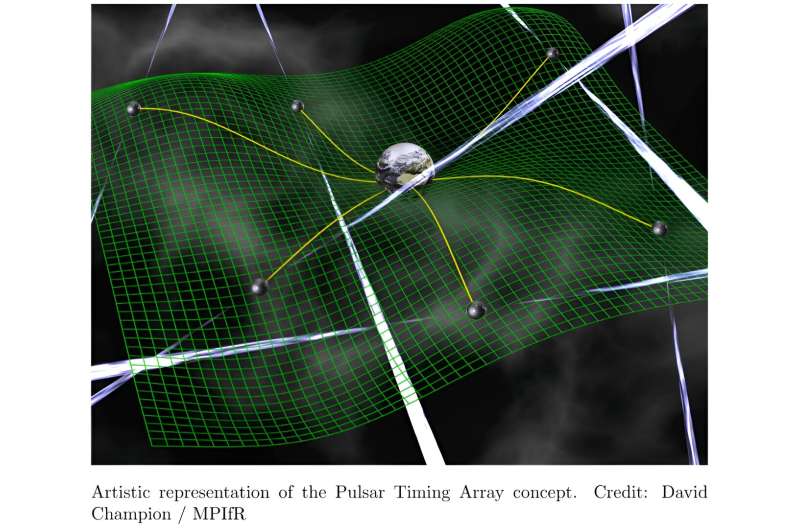November 24, 2023 feature
This article has been reviewed according to Science X's editorial process and policies. Editors have highlighted the following attributes while ensuring the content's credibility:
fact-checked
peer-reviewed publication
trusted source
proofread
New constraints on the presence of ultralight dark matter in the Milky Way

Dark matter, composed of particles that do not reflect, emit or absorb light, is predicted to make up most of the matter in the universe. Its lack of interactions with light, however, prevents its direct detection using conventional experimental methods.
Physicists have been trying to devise alternative methods to detect and study dark matter for decades, yet many questions about its nature and its presence in our galaxy remain unanswered. Pulsar Timing Array (PTA) experiments have been trying to probe the presence of so-called ultralight dark matter particles by examining the timing of an ensemble of galactic millisecond radio pulsars (i.e., celestial objects that emit regular millisecond-long radio wave pulses).
The European Pulsar Timing Array, a multinational team of researchers based at different institutes that is using 6 radio-telescopes across Europe to observe specific pulsars, recently analyzed the second wave of data they collected. Their paper, published in Physical Review Letters, sets more stringent constraints on the presence of ultralight dark matter in the Milky Way.
"This paper was basically the result of my first Ph.D. project," Clemente Smarra, co-author of the paper, told Phys.org. "The idea arose when I asked my supervisor if I could carry out research focusing on gravitational wave science, but from a particle physics perspective. The main aim of the project was to constrain the presence of the so-called ultralight dark matter in our galaxy."
Ultralight dark matter is a hypothetical dark matter candidate, made up of very light particles that could potentially address long-standing mysteries in the field of astrophysics. The recent study by Smarra and his colleagues was aimed at probing the possible presence of this type of dark matter in our galaxy, via data collected by the European Pulsar Timing Array.
"We were inspired by previous efforts in this field, especially by the work of Porayko and her collaborators," Smarra said. "Thanks to the longer duration and the improved precision of our dataset, we were able to put more stringent constraints on the presence of ultralight dark matter in the Milky Way,"
The recent paper by the European Pulsar Timing Array makes different assumptions than those made by other studies carried out in the past. Instead of probing interactions between dark matter and ordinary matter, it assumes that these interactions only occur via gravitational effects.
"We assumed that dark matter interacts with ordinary matter only through gravitational interaction," Smarra explained. "This is a rather robust claim: in fact, the only sure thing we know about dark matter is that it interacts gravitationally. In a few words, dark matter produces potential wells in which pulsar radio beams travel. But the depth of these wells is periodic in time, therefore the travel time of the radio beams from pulsars to the Earth changes with a distinctive periodicity as well."
By looking for this particular effect within the second wave of data released by the European Pulsar Timing Array, Smarra and his colleagues were able to set new constraints on the presence of ultralight dark matter around pulsars. The European Pulsar Timing Array has been collecting this data for almost 25 years, using 6 sophisticated radio telescopes situated in different places around Europe.
"Based on our analyses, we can exclude that ultralight particles in a specific range of masses can constitute the full amount of dark matter," Smarra said. "Therefore, if they were there, we would still need something else to explain what we see. And this result is rather robust, as we focused on the gravitational interaction of dark matter, which is the only thing we know for sure."
The recent work by the European Pulsar Timing Array shows that ultralight particles with masses of 10−24.0 eV≲m≲10−23.3 eV cannot constitute 100% of the measured local dark matter density and can have at most a local density of ρ≲0.3 GeV/cm3. These new constraints could guide further research in this area, potentially informing future searches for this elusive dark matter candidate.
"I am currently planning to explore whether pulsars have signatures that can tell us something more about dark matter," Smarra added. "Moreover, I am generally interested in the PTA science; therefore I would also like to work on the astrophysical modeling of supermassive black hole binary systems, which are believed to be a compelling explanation for the stochastic gravitational wave background we have recently observed."
More information: Clemente Smarra et al, Second data release from the European Pulsar Timing Array: Challenging the ultralight dark matter paradigm, Physical Review Letters (2023). DOI: 10.1103/PhysRevLett.131.171001
Journal information: Physical Review Letters
© 2023 Science X Network





















